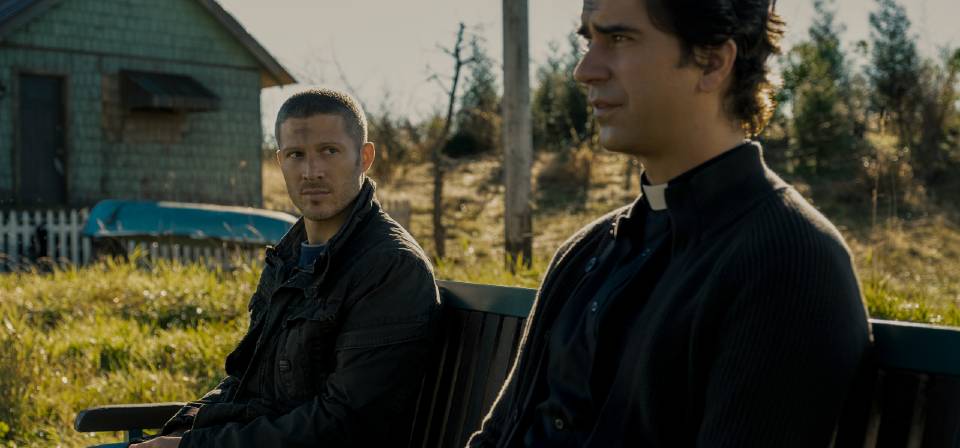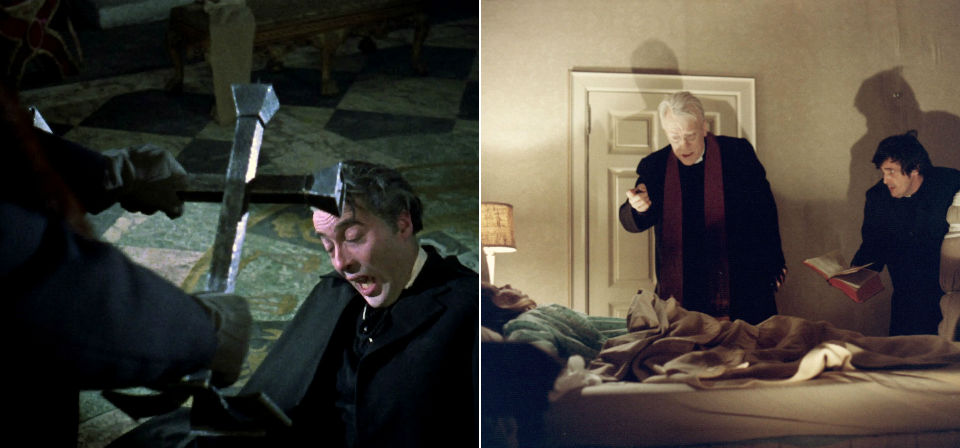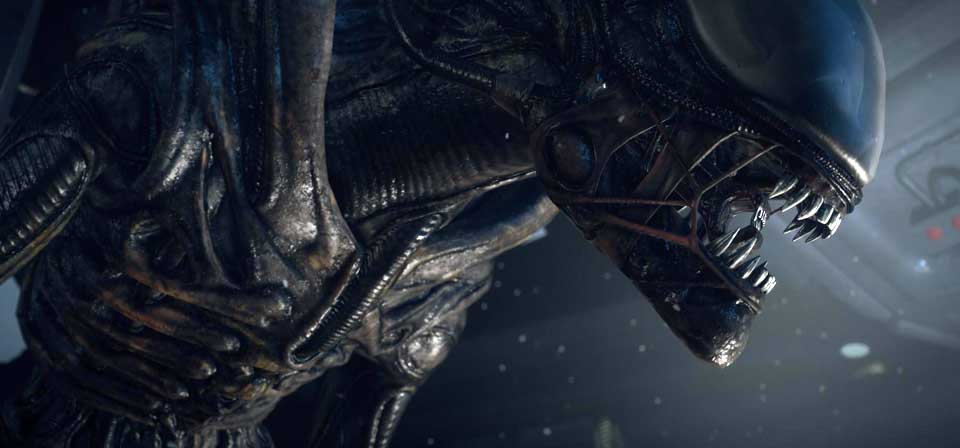Tags :: Horror

Jurassic World Dominion (2022)
The word “dominion” is uttered once in Jurassic World Dominion, in an oblique, irreverent allusion to Genesis 1. “Not only do we lack dominion over nature, we are subordinate to it,” asserts Dr. Ian Malcolm (Jeff Goldblum) in one of his trademark, smugly iconoclastic epigrams. Later in the same speech, though, Malcolm turns with surprising optimism to the power of genetic science to shape the future. Does he really believe this? Is this speech coherent? Is the film itself coherent?

The sacred and the profane: Religious themes in vampire fiction
Almost from the beginning, vampire fiction has been a battleground between the powers of heaven and hell.

Midnight Mass is drenched in blood and Catholicism, but there’s one thing missing
Midnight Mass isn’t the first vampire story to blend vampirism as a metaphor for addiction with literal substance abuse. It is, however, probably the only paranormal horror story to focus so intently on the role of religion in recovery.

A Quiet Place Part II (2021)
There are day-to-day crises and traumas that are somehow absorbed into the continuity of our lives, and then there are inexorable turning points that divide our lives into “before” and “after.”
![Midsommar [video]](/uploads/articles/midsommarjpg.jpeg)
Midsommar [video]
Why does Robin Hardy’s disquietingly cheery 1973 British folk-horror classic The Wicker Man work better than this sophomore film from the writer-director of Hereditary?
![The Dead Don’t Die [video]](/uploads/articles/deaddontdie.jpg)
The Dead Don’t Die [video] (2019)
I mean, you can kill them, but that’s not the point. The question is, were they ever alive in the first place?

Jurassic World: Fallen Kingdom (2018)
Apparently velociraptor is the cowbell of dino design and the filmmakers are Christopher Walken.
![A Quiet Place [video]](/uploads/articles/quietplace-vid.jpeg)
A Quiet Place [video] (2018)
It’s funny to think of people scratching their heads when this “quiet” film is justly nominated for sound editing and sound mixing Oscars.

A Quiet Place (2018)
While A Quiet Place is a terrific film just the way it is, I can’t help wishing there were more families like this in other kinds of movies.

The Mummy (2017)
I have never seen a movie work harder or more hopelessly than Universal’s new The Mummy, not merely to launch a new franchise, but to jump from a standing start into a full-blown Marvel-style shared cinematic universe in one go.

Alien: Covenant (2017)
To succumb to a regrettable but practically inevitable coinage, Scott wants to make the world of Alien great again — to remind us all what was so terrifying nearly four decades ago about being in space where no one can hear you scream.

An inherited nightmare: Watching the Puritan horror of The Witch with Catholic eyes
What is most unsettling about The Witch is not the manifest presence of the Devil and the malevolence of his minions, but the seeming absence of God and the impotence of the family’s faith and prayers.
![The Shallows [video]](/uploads/articles/shallows.jpg)
The Shallows [video]
“Blake Lively versus shark” is definitely one of the better pitches of this summer.

The Conjuring 2 (2016)
Wan goes bigger and splashier here than in the first Conjuring. Metaphorically splashier, I mean; it’s not very bloody, but it’s bloody scary, thanks to Wan’s skills and some shrewd choices by Chad and Carey Hayes, the screenwriting brothers (both Christians) who wrote both films.

Vampires, demons and the cross: Catholicism and horror
“When it comes to fighting vampires and performing exorcisms, the Roman Catholic Church has the heavy artillery” is how Roger Ebert opened his review of John Carpenter’s Vampires.

A Nightmare on Elm Street (1984)
Nightmare’s surreal scares go beyond most slasher fare by evoking an irrational world in which normal rational defenses don’t apply.

Stop-Motion Macabre
Stop-motion animation — which, unlike computer animation and traditional hand-drawn cel animation, utilizes real objects shot frame by frame, with tiny adjustments made between shots — is a defiantly old-fashioned, niche medium, often used to creepy effect: Henry Selick’s The Nightmare Before Christmas and Coraline; Tim Burton’s Corpse Bride and Frankenweenie; Aardman’s Wallace and Gromit: Curse of the Were-Rabbit.
Deliver Us From Evil [video] (2014)
Édgar Ramírez might be my favorite horror-movie priest.
Scott Derrickson: The Epic Video Interview!
Scott Derrickson is such a great interview subject that it was hard for me to cut down our sprawling 45-minute discussion to the 2500-odd words of the text article that ran earlier this week. I’m very pleased, then, to be able to offer the Reel Faith video version of the entire interview.

Deliver Us From Evil (2014)
Why would a mother at the zoo throw her toddler over a railing into the moat of a lion enclosure? That’s the kind of horrible question that can look very different if you are a police officer or a priest.
Interview: Filmmaker Scott Derrickson on Horror, Faith, Chesterton and Deliver Us From Evil
Scott Derrickson is a very nice guy who makes movies about things that aren’t very nice.
Exorcism in the Movies
In a way, The Exorcist is a pivotal film — the indispensable link between the Catholic-inflected piety of Golden Age Hollywood and the demonic world of latter-day horror.
![The Conjuring [video]](/uploads/articles/conjuring.jpg)
The Conjuring [video]
Thirty years after The Exorcist, when it comes to fighting the powers of hell, the Catholic Church still has the heavy artillery, as Roger Ebert once wrote.
World War Z [video]
It’s the end of the world was we know it … again. World War Z: my “Reel Faith” 60-second review.
Evil Dead [video]
Producer Sam Raimi has been milking this premise since 1978. It’s no longer plausible that these teenagers still haven’t seen any movies like this.

ParaNorman (2012)
Why does stop-motion animation work so well as a medium for the macabre, from The Nightmare Before Christmas to Tim Burton’s Corpse Bride to Coraline?
Prometheus [video]
Prometheus in 60 seconds: my “Reel Faith” review.
Prometheus (2012)
I don’t mind that Prometheus raises big questions without ultimately answering them. Unanswered questions are part of life, and there’s no reason you can’t have them in art. I do mind that Prometheus raises big questions and has virtually nothing interesting, insightful or thoughtful to say about them. If the questions aren’t interesting in this film, why should anyone care whether they’re answered in another one?

Dark Shadows (2012)
If you are in love with the 1970s and Johnny Depp, perhaps you will enjoy this. Andrew O’Hehir says he knew he would love the film when he spotted a banana-seat Schwinn bicycle leaning against the front porch of Collinwood in an early scene. All right. But then comes a “happening” featuring Alice Cooper as himself (!), with a disco ball and cage dancers. At Collinwood. Is this really anyone’s idea of a good time?
The Woman in Black (2012)
For Harry Potter star Daniel Radcliffe, who stars as a young solicitor named Arthur Kipps, The Woman in Black is an opportunity to make a reasonably graceful break from the role that has dominated his life since childhood. For the new owners of England’s legendary Hammer horror brand, until recently dormant from the 1970s, it’s an opportunity to stake their claim to continuing in the tradition of Terence Fisher, Jimmy Sangster et al. For curious movie watchers, it’s an opportunity to see how Radcliffe does in another role — and how an old-fashioned haunted house story plays today.
Priest (2011)
Director Scott Charles Stewart seems to be making a career out of erasing Jesus from history, and celebrating supernatural heroes who rebel against God for the greater good … in apocalyptic action/horror movies starring Paul Bettany.
Red Riding Hood (2011)
Red Riding Hood is a movie of a sort that I would very much like to see if anyone could make it, which is another way of saying that it is not that sort of movie at all. A real Hollywood fairy tale is the rarest thing in the world. Hollywood is more comfortable with myth and legend. Partly, I think, it’s a matter of scale: Mythology provides the sort of sweeping, epic scope that lends itself to big-screen Hollywood feature filmmaking. Fairy tales are smaller and more intimate, and require a lighter touch.
The Rite (2011)
In some ways, Mikael Håfström’s new film reminds me less of recent exorcism films than of the sort of movie that Terence Fisher made for Hammer Films in the late 1950s and 1960s, movies like The Devil Rides Out and the 1958 Dracula. If Father Lucas, an unconventional veteran exorcist working in Rome, had been played by Hammer icon Christopher Lee instead of Anthony Hopkins, he would have been right at home.

Horror, the grotesque, and the macabre: A Christian appraisal
Horror represents a field many Christians approach with trepidation, and rightly so. The horror shelves of bookstores and video stores are very largely a wasteland of mindless, tasteless trash; indeed, there may be no other genre as disproportionately overrun with junk. Yet the grotesque, the macabre, and the frightful have an abiding place in human imagination and culture — a place that Christian sensibility has historically not seen fit to reject or condemn, at least entirely.

The Wolfman (2010)
The Wolfman retells the classic werewolf story, but has little to add besides volume and gore. It’s like a haunted house where they never stop jumping out and saying “Boo!”
Twilight Appeal: The cult of Edward Cullen and vampire love in Stephenie Meyer’s novels and the new film (2008)
Chastity is a precious thing, and the struggle to be chaste is both an inevitable part of a moral life and a legitimate subject for narrative art. In part, this quest for chastity may legitimately form some part of Twilight’s appeal. At the same time, a narrative that wallows in the intoxicating power of temptation and desire, that returns again and again to rhapsodizing about the beauty of forbidden fruit, may reasonably be felt to be a hindrance rather than an affirmation of self-mastery.
The Wicker Man (1973)
Is The Wicker Man anti-Christian? Anti-pagan? Anti-religion? Where are its sympathies? Does it have any? Like baffled, blustering Sergeant Howie, blundering about the clannish Summerisle community trying to investigate a missing child, we are asking the wrong questions, assuming the wrong rules, wandering ever further off course, walking into a trap.
Hellboy and Spiritual Warfare, Hollywood Style
You won’t find the gospel in movies like Hellboy. What you may find is signs of a world that has been touched by the gospel — a world that retains some awareness of sinister forces to be avoided or resisted, of evil that cannot be overcome by therapy or education or communication, that calls for a response from another realm entirely.
Ghost Rider (2007)
For all their evident interest and affinity for the material, though, the filmmakers haven’t made a very good movie. They’ve figured out how to get Blaze (Cage), the motorcycle-riding hellion who makes a deal with the devil, into the same picture as Carter Slade (Sam Elliott), the originally unconnected (and not even supernatural) Ghost Rider of the Old West. But they haven’t figured out either who Johnny Blaze is as a character, or what the Ghost Rider is all about.
Monster House (2006)
In a way, Monster House is a bracingly icy breath of fresh air, a tween-oriented family film that is unabashedly out to frighten.
Jaws (1975)
Steven Spielberg’s breakout hit is a perfect storm of primal fears (man-eating predators, the unseen, the ocean), shrewd, emotionally riveting direction combined with sympathetic lead performances, and that classic two-note theme from John Williams’ edgy score.

Wallace & Gromit: The Curse of the Were-Rabbit (2005)
Stop-motion animation cult heroes Wallace & Gromit, the brainchildren of British animator Nick Park of Aardman Animations, may not be unchanged in the transition from their charmingly dotty, wildly funny shorts to their first feature-length film, but they’re still recognizably themselves.
Corpse Bride (2005)
As imagined by Tim Burton in stunning, wildly stylized stop-motion animation overtly reminiscent of The Nightmare Before Christmas yet technically far beyond it, this macabre fairy tale becomes, variously, a poignant meditation on the daunting weightiness of the vows of marriage, a raucous danse macabre in jumping jazz rhythms and florid colors, a visually rich celebration of Edward Gorey Gothic-Victorian and Charles Addams grotesque, and, perhaps most surprisingly, a touching portrait of tragedy, doomed love, empathy, and sacrifice.
The Exorcist (1973)
“You just take your pills and you’ll be fine, really,” Chris (Ellen Burstyn) promises her daughter Regan (Linda Blair), but part of the film’s brief is that pills aren’t the answer to everything, and faith and religion may have answers science doesn’t.
The Exorcism of Emily Rose (2005)
A line in the trailer for The Exorcism of Emily Rose, felicitously cut from the final film, observes that “There’s no pill for the devil.” More to the point, there’s no diagnostic test or scan for him, either.
Constantine (2005)
The comic-book Constantine is a blond Brit based in Liverpool (think Sting by way of Christopher Lee in Terence Fisher’s The Devil Rides Out). For the film, the casting of Keanu led to a change of setting to California and LA. Similarly, the casting of Shia LaBeouf (Holes) as Constantine’s ally Chandler turned the character from a seasoned comrade in arms into a Jimmy Olsen-like junior sidekick. (Whatever happened to casting actors who fit the part?)
The Cross and the Vampire: Religious Themes in Terence Fisher’s Hammer Horrors
The religious themes in the B-movie horror films directed by Terence Fisher for Hammer Films could fill a book. In fact, there is such a book.
The Sixth Sense (1999)
A ubiquitous tagline and a mind-bending climactic twist made M. Night Shyamalan’s breakout hit The Sixth Sense a monster sensation — yet this deliberately paced, psychologically sensitive paranormal thriller is much more than a one-trick puzzle movie, and holds up well to multiple viewings.
The Silence of the Lambs (1991)
Lecter fascinates us because he embodies qualities that we associate with civilized, reasonable existence, yet he is murderously sociopathic. In our therapeutic age, he’s a shocking reminder that, beyond all psychobabble about “behavior modification” and the like, there remains the sheer reality of good and evil. The doctor is in: God help us all.
Pirates of the Caribbean: The Curse of the Black Pearl (2003)
The most remarkable thing about Pirates of the Caribbean: The Curse of the Black Pearl is neither Johnny Depp’s mesmerizing performance, nor ILM’s literally eye-popping skeletal ghost-ship crew, but the sheer fact that the movie works at all.
Nosferatu: A Symphony of Horror (1922)
Though diminished by decades of pop-horror incarnations, the vampire remains uniquely evocative of both dread and fascination, horror and seductiveness. Monsters from werewolves to Freddy Krueger may frighten, but neither victims nor audience are drawn to them. By contrast, the vampire suggests the horror of evil working on our disordered passions.
The Cell (2000)
The Cell gives imaginative and visual shape to as it were the very soul of misogynism, perversion, depravity, sadism, and the supreme nihilism and egotism of the damned. The film also has some images of beauty, peace, and serenity; even some Christian symbolism — but all this is quickly overwhelmed, even betrayed and subverted, so that the dark themes dominate the film.
Hannibal (2001)
As directed by Ridley Scott (Gladiator), Hannibal is stylishly mounted and has its entertaining moments. Ultimately, though, it’s like most horror movies: repellent where it should have been frightening, and, in the end, uninvolving and hollow. So many characters suffer such ghastly things, yet none of it seems to matter much.

Shadow of the Vampire (2001)
The making of Nosferatu — the first (if unauthorized) film version of Bram Stoker’s Dracula, and one of the 45 films on the Vatican film list — has passed into legend. Denied rights to Dracula by Stoker’s widow, German director F. W. Murnau simply had an adapted screenplay written with alternate character names: Count Dracula became "Count Orlock," Jonathan Harker became "Thomas Hutter," and so on. (Substantial changes were so minimal that at least one English-language edition actually restores Stoker’s original names in the title cards.)
Something Wicked This Way Comes (1983)
This line from Macbeth, quoted by small-town librarian Charles Halloway (Jason Robards), perfectly evokes the unsettling milieu of Ray Bradbury’s dreamlike thriller about a creepy carnival coming to a small Illinois town. Significantly, this line is immediately followed in the film by the following verse from Longfellow, also quoted in the book:
What Lies Beneath (2000)
But when the plot then descends into a Lethal Weapon-type action-chase scene, it’s clearly gone off the rails: a proper ghost story has an entirely different atmosphere from a Lethal Weapon action flick.
Willard (2003)
The original 1971 Willard, a nasty B-grade horror flick about an oppressed misfit whose only friends are an ever-growing army of rats, was not a movie that cried out for a remake. Given the decision to make one, though, it’s hard to imagine a more fitting casting choice than Crispin Glover.
The Others (2001)
Then re-anchor the story to reality by asking whether there are really any ghosts at all — whether apparently spectral manifestations might not in fact be no more than an unstable woman’s imaginings, or the cruel pranks of a spiteful child, or the malicious work of mysterious servants with unguessable motives. Bear in mind that moviegoers are increasingly wise to Sixth-Sense style tricks, and will carefully analyze each of these characters in turn, trying to figure out what might not be as it seems.
Recent
- Benoit Blanc goes to church: Mysteries and faith in Wake Up Dead Man
- Are there too many Jesus movies?
- Antidote to the digital revolution: Carlo Acutis: Roadmap to Reality
- “Not I, But God”: Interview with Carlo Acutis: Roadmap to Reality director Tim Moriarty
- Gunn’s Superman is silly and sincere, and that’s good. It could be smarter.
Home Video
Copyright © 2000– Steven D. Greydanus. All rights reserved.